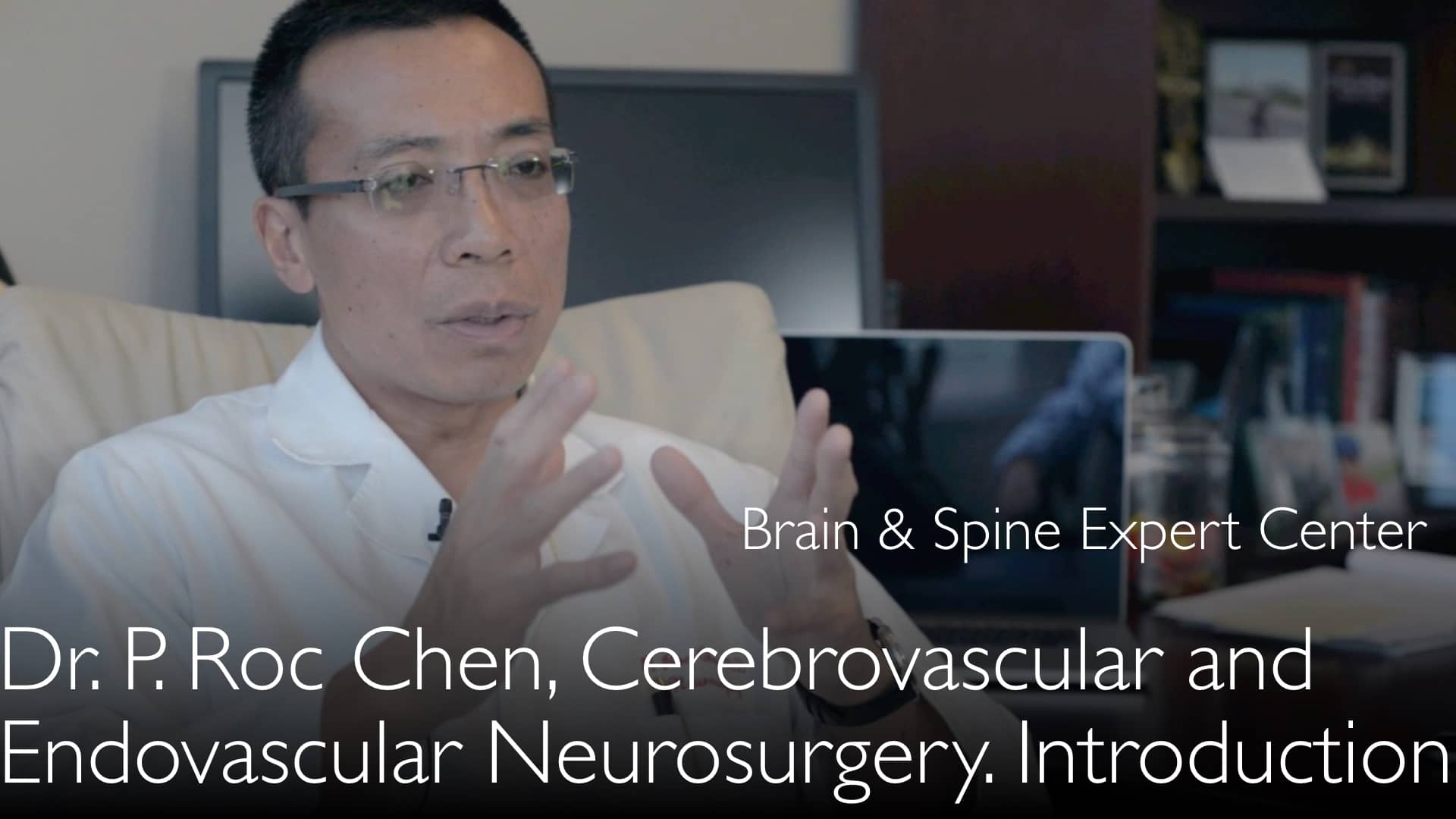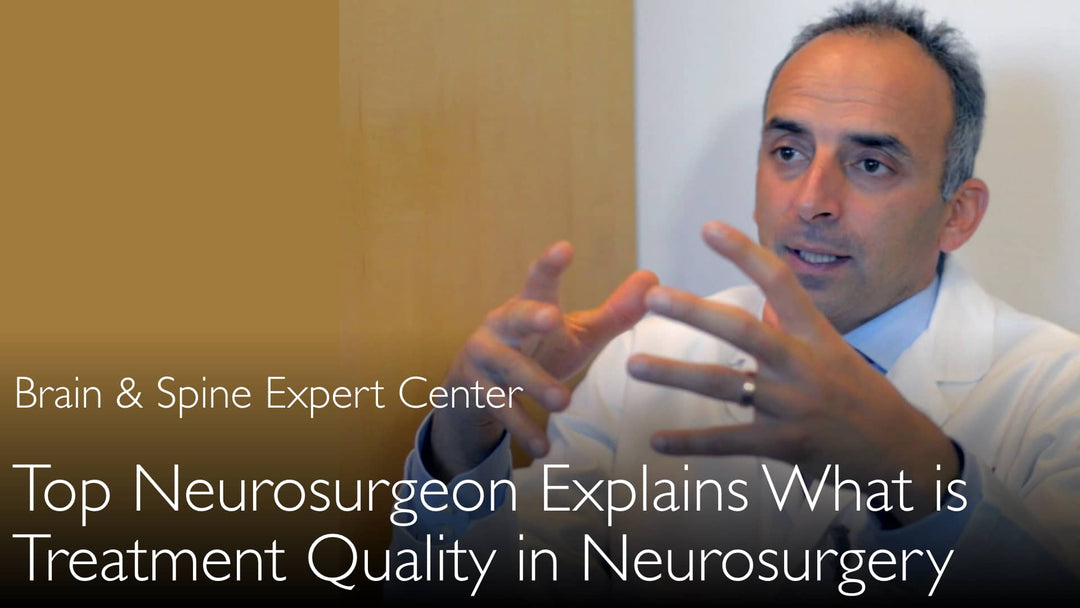Leading expert in cerebrovascular surgery, Dr. Peng Chen, MD, explains how combining endovascular and open brain surgery techniques significantly improves patient outcomes for complex conditions like brain aneurysms, arteriovenous malformations (AVMs), and carotid stenosis. This dual-approach strategy, tailored to individual patient needs, leverages the strengths of both minimally invasive catheter-based procedures and traditional microsurgery to reduce procedural risks and enhance recovery, especially in high-grade cases with poor neurological status.
Combined Endovascular and Open Surgical Approaches for Brain Vascular Disorders
Jump To Section
- Brain Aneurysm Treatment Evolution
- High-Grade Patient Outcomes with Combined Therapy
- AVM and Occlusive Disease Applications
- Carotid Stenosis Treatment Options
- CREST Trial Findings on Stenting vs. Surgery
- Personalized Treatment Planning for Better Results
- Full Transcript
Brain Aneurysm Treatment Evolution
Dr. Peng Chen, MD, identifies brain aneurysms as a critical cerebrovascular condition where a ruptured aneurysm carries a high mortality rate. For decades, open microsurgical clipping was the sole treatment option. However, as Dr. Peng Chen, MD, explains, the last twenty years have seen the rise of endovascular coil embolization, a minimally invasive technique performed via catheter. Major clinical trials from Europe and the United States have provided data suggesting that for some patients, endovascular treatment offers a better recovery trajectory in the initial years following a rupture compared to open surgery alone.
High-Grade Patient Outcomes with Combined Therapy
The most significant benefits emerge for high-grade patients, those presenting with a very poor neurological status after an aneurysm rupture. Dr. Peng Chen, MD, details his institution's prospective research, which followed a group of aneurysm patients. Their data, recently presented at the Congress of Neurological Surgeons annual meeting, demonstrates that a treatment strategy combining endovascular and open surgical approaches—while leaning more towards endovascular methods—yields superior outcomes for these critically ill patients compared to a traditionally dominant open surgery protocol.
AVM and Occlusive Disease Applications
Beyond aneurysms, Dr. Peng Chen, MD, highlights two other major disease categories amenable to a combined approach. Arteriovenous malformations (AVMs) involve an abnormal, high-flow connection between arteries and veins, creating a short circuit. Carotid occlusive disease, or stenosis, is a leading cause of ischemic strokes. For both complex AVMs and symptomatic carotid stenosis, a multimodal strategy that strategically employs endovascular and open techniques can often achieve a more complete and safer result than either method could alone.
Carotid Stenosis Treatment Options
The treatment landscape for carotid stenosis exemplifies the evolution of cerebrovascular care. Dr. Peng Chen, MD, notes that robust Class One data from 1980s and 1990s trials firmly established the benefit of open carotid endarterectomy surgery for stroke prevention. This procedure involves surgically removing the plaque from the carotid artery. In parallel, endovascular carotid artery stenting, which uses a balloon and stent to open the narrowed artery from within, has grown increasingly popular over the last decade, offering a less invasive alternative.
CREST Trial Findings on Stenting vs. Surgery
The critical question of whether stenting was as effective as surgery was answered by the landmark CREST trial. As explained by Dr. Peng Chen, MD, this randomized clinical trial compared open surgery directly with endovascular balloon angioplasty and stenting. The results demonstrated no significant statistical difference in overall outcomes between the two treatment groups. This pivotal finding means that physicians now have two validated options for treating carotid stenosis, each with its own profile of procedure-related risks and potential complications.
Personalized Treatment Planning for Better Results
The ultimate benefit of having multiple treatment modalities is the ability to personalize care. Dr. Peng Chen, MD, emphasizes that by focusing on each patient individually and analyzing their specific anatomy, age, and comorbidities, neurosurgeons can select the optimal treatment modality—open, endovascular, or a combination. This careful, patient-centric planning allows physicians to minimize the overall procedural risk for treating diseases like carotid stenosis, ultimately delivering the best possible result and maximizing benefit for the patient.
Full Transcript
Dr. Anton Titov, MD: What are some of the examples of vascular problems in the brain that are most amenable to the combination of endovascular approach and open surgery?
Dr. Peng Chen, MD: Cerebrovascular surgery includes brain aneurysms, which is one of the diseases that are not well-known by everyone. When you have a brain aneurysm rupture, it tends to have a high mortality.
The second condition is called arteriovenous malformation, where the artery and vein have a wrong connection with a short circuit shunting. There is also a so-called occlusive disease, which is carotid stenosis, known as a cause of ischemic strokes.
In all of these diseases, you would see the benefit of a combination of endovascular and open brain surgery treatments. For example, in brain aneurysm treatment, traditionally, open surgery was the only option. Over the last 20-some years, it developed into so-called coil embolization, where we use a catheter to treat these patients.
We see in the European trial and also in a trial from this country data that suggest some patients with brain aneurysm rupture do benefit from endovascular treatment a little bit better than from open surgery in their first few years of recovery. We also, at our own institution, prospectively follow up a group of brain aneurysm patients over the last few years.
We see that combined endovascular and open surgery to assess high-grade patients, which means patients have a very poor neurological status when they come in with the aneurysm rupture, when they are treated with combined endovascular and open surgery, and also leaning more towards endovascular treatment, their outcome is better than when done by a traditionally dominant open brain surgery. We showed that data recently; it was just presented at the Congress of Neurological Surgeons annual meeting.
At the same time, if you look at carotid disease, in the 1980s and 90s, clinical trials showed the strong benefit of open surgery carotid endarterectomy to prevent stroke. That is a very clear benefit; this is Class One data.
However, over the last 10+ years, the endovascular procedure with balloon angioplasty and stenting for carotid disease has gradually become more popular in this country and in Europe. For a period of time, we didn't know whether the endovascular technique was as good as surgery.
A recent trial, so-called CREST, randomized two groups of patients to open surgery versus endovascular balloon angioplasty and stenting. It demonstrated that there is no significant difference from a statistical standpoint.
The true meaning of this is that we now have more options for patients with the same type of disease that we treat with open surgery or endovascularly. They all have different potential procedure-related risks and complications.
If we focus on each patient individually and analyze them to choose the best treatment modality, we can bring the overall risk to treat this carotid disease much better. In that way, we are able to bring down the potential procedure risks.
That ultimately benefits the patient!








